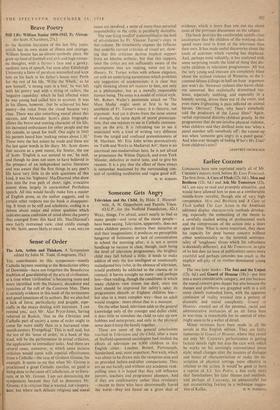Someone Gets Angry
Television and the Child. By Hilde T. Himmel-
weit, A. N. Oppenheim and Pamela Vince.
(O.U.P., for the Nuffield Foundation, 42s.) WELL, things, I'm afraid, aren't nearly as bad as many people—and some of the nicest people— have been saying. Television, apparently, does not make children passive, destroy their initiative or dull their imaginations; it produces no perceptible hangover of listlessness or lack of concentration in school the morning after; it is not a severe handicap to success in class, though, such being the level of television programmes, the brighter child may fall behind a little; it tends to make addicts of only the less intelligent or emotionally maladjusted boy (who, in the absence of television, would probably be addicted to the cinema or to comics); it harms eyesight no more—and perhaps less—than reading, though the conditions in which many children view (room too dark, seats too low) should be improved for safety's sake; its programmes disturb or frighten children less— but also in a more complex way—than an adult would imagine: more about that in a moment.
On the other hand, television adds to the general knowledge only of the younger and duller child; it does little to stimulate the child to take up new hobbies and enterprises; and only in the physical sense does it keep the family together.
These are some of the general conclusions reached in Television and the Child, after a team of Nullield-sponsored sociologists had studied the effects of television on 4,000 children in five English cities : London, Bristol, Portsmouth, Sunderland, and, most important, Norwich, which was about to be drawn into the reception area and so provided before-and-after comparisons. They are set out lucidly and without any academic rank- pulling since it is hoped that they will influence parents, teachers and programme planners. And if they are confirmatory rather than revelatory —except to those who have determinedly feared the worst—they are based on a great deal of
evidence, which is more than you can say about most of the previous discussions on the subject.
The book destroys the comfortable middle-class assumption that the children of the working class spend more time in front of the television than their own. It has made useful discoveries about the kinds of activities which viewing has displaced. And, perhaps most valuably, it has analysed with sonic surprising results the kind of thing that dis- turbs children in television programmes. All but the very young and insecure are completely blase about the stylised violence of Westerns, so the I- counted-fifteen-killings-in-half-an-hour argument just won't do. Newsreel violence also leaves child- ren unmoved. But realistically dramatised vio- lence, especially stabbing, and especially in a homely setting, drives them out of the room, and even more frightening is pain inflicted on animal heroes. Obvious? Then, why hasn't somebody told the producers of the Lassie films? Again, verbal reprimand disturbs children greatly. In the programmes that do not involve physical violence, what children said they disliked most was 'when a panel member tells somebody off'; the runner-up was when 'someone gets angry in a panel game.' And who ever thought of hiding What's My Line? from children's eyes?
GEOFFREY NICHOLSON


























 Previous page
Previous page